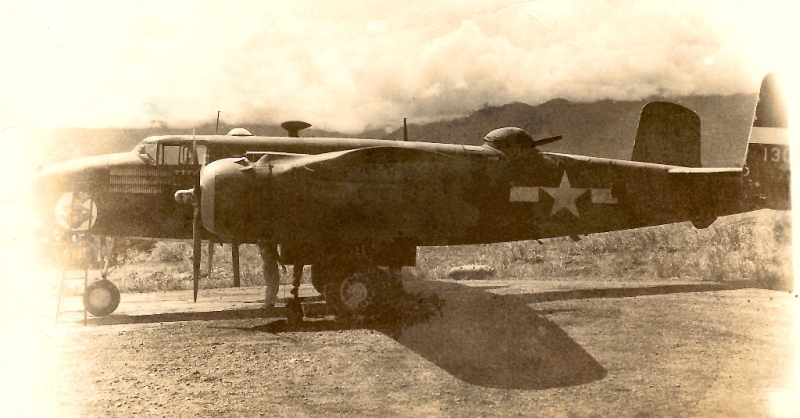
As a child, there was a footlocker at the foot of my bed that contained all the artifacts that encompassed the brief life of an uncle. Sometimes we would open up that trunk and handle all the contents that included his civilian flight logbook, some uniform pieces, Army Air Force collar insignia, a stack of hand painted nose art samples, and some jewelry.
I remember holiday dinners where us kids would be in the living room and we could hear bits of conversations coming from the parents and uncles in the kitchen that included exotic words like New Guinea, Wewak, and New Caledonia. There wasn’t much open discussion on the loss of that uncle, perhaps because the lives of my grandparents were forever diminished by the loss of a son.
A quantity of human remains and personal effects had been recovered from the crash site by an Australian Graves team in 1946 and were interred in a group burial in 1951. From post-war letters between my mom and the Army, I believe that my grandparents had some major doubts as to the whether their son was actually accounted for among those remains.

Back in the early 90’s, my job had me working on an overnight shift. On the weekends, I found myself awake while my family slept, so as a way to stay quiet, I began searching the internet for information about that uncle that had died in the Pacific during World War 2. All I knew when I started was his name, Warren W. Everett, and the words New Guinea, Wewak, and New Caledonia that I associated with him. There didn’t seem to be much information available online back then but I learned all about being creative with search terms.
My search results were negligible for many months until my youngest brother found a bunch of old letters and gave me the wartime address for the uncle. Then I came across a link to the Air Force Historical Support Office (AFHSO). I contacted that agency and they provided me with a copy of the Missing Air Crew Report for the crash in which he died. Once I had the bomb group, squadron and the MACR number, the amount of information I came across began to increase exponentially. I followed a lot of links that would ultimately lead to more links and more bits of information. I was able to make contact with veterans of his bomb group through the 345th Bomb Group Association, who provided copies of documents for his final mission and answered my questions about their time overseas. One link brought me to know Gerald Sims, the crew chief of the Tin Liz and his son-in-law, Duffy Soto, who provided me with documents and pictures concerning that airplane.

By the mid 2000’s, I had accumulated enough information that I began to entertain the notion of a trip to Papua New Guinea to visit the crash site. An unexpected change in my domestic situation allowed that dream to become a reality. On May 21, 2009, on the sixty-fifth anniversary of the crash, I was standing on top of the remnants of the right wing of the Tin Liz. All around me, in a small clearing in a sago swamp just southeast of the old Dagua airstrip, there were large pieces of twisted aluminum, lots of small bits of wreckage, and two radial engines that were sinking slowly into the soft soil.

As a result of all the research to get me to the crash site, I had accumulated all kinds of documentation of missions flown by the 345th Bomb Group for the entire war. I had manuals for everything from how to fly the B-25 bomber to the aircraft parts lists and repair procedures. I had several comprehensive books that had been written about the exploits of the bomb group as well as personal accounts that had been published by members of the group. I had contacts with a bunch of people who were also interested in keeping the history of the 345th alive. There was enough information to form some theories on how and why the Tin Liz was shot down.
I set about digesting all the information and trying out different ways to turn it into a useful database for others to use. That bring us up to this blog and why it is here. It is my intention to publish here, for public use, interactive maps of the missions of the 345th Bomb Group during World War 2. Some maps will display combat missions from the broader perspective of the Group while others will focus in on squadron, flight, and individual aircraft level information. I believe I can produce an interactive map that will cover the combat missions flown by my uncle. Where available, the crew member names for each mission will be linked to each airplane in popups. Along with the maps, I will undoubtedly include some of my thoughts and conclusions drawn from the data and relate some of my travel experiences.
